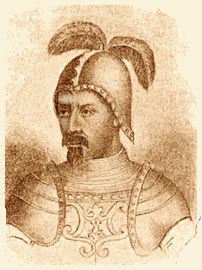
19th Century engraving of the soldier-poet Luigi da Porto
UNLUCKY IN LOVE – THE MAN WHO CREATED ROMEO & JULIET
Though Shakespeare’s “Romeo & Juliet” is by far the best known version of the story, the tragic tale of Verona’s star-crossed lovers first appeared in print long before The Bard’s play was performed. As was his usual practice, Shakespeare used a number of sources as inspiration for his drama but it was the Italian soldier and poet Luigi da Porto who created Romeo & Juliet in its first recognisable form.
It was da Porto who named the principle characters Romeo and Juliet and the feuding families Montague (Montecchi) and Capulet (Cappelletti). It was da Porto who set the story in Verona and it was he who introduced Friar Lawrence, Mercutio, Paris and Tybalt into the plot. Moreover, though da Porto probably borrowed heavily from an even earlier Sienese version of the story (“Mariotto e Ganozza” by Masuccio Salernitan) he also drew on his own bitter experiences of love.
Luigi da Porto was born in Vicenza on the 10th of August 1485 but, after his parents died, he was brought up by relatives in Urbino before being packed off to Venice to learn the arts of war. Happily, being a soldier seems to have suited him, and the young da Porto distinguished himself several times in battle. However, during the War of the League of Cambrai [1508-1516], he was so severely wounded he was forced to quit the martial life. He therefore retired to his villa in Montorso Vicentino and became a poet.
In imitation of Dante, who dedicated his greatest works to his unrequited love Beatrice, da Porto wrote numerous verses to an anonymous lady whom he referred to only as Ginevra or Juniper. According to one 19th Century biographer, this lady “never gave him rest” and continued to toy with his affections for 15 years until her death. The same biographer adds:
“…our da Porto loved, loved much, and loved ardently; but though he possessed all that could have satisfied feminine pride, namely, a handsome person, great genius, and an illustrious name, nevertheless he was many times, if not always, disappointed in return…”
It was this terrible luck in love that led da Porto to write his rather clumsily titled: “A Story Newly Found Of Two Noble Lovers, with Their Pitiful Death which Happened in the City Of Verona During the Reign of Bartolommeo Della Scala”. Though he wrote it c.1524 this short novella wasn’t published until after his death in 1529. Moreover, the heroine of “Two Noble Lovers” is not meant to symbolise Ginerva but his cousin Lucina Sarvognan.
In 1511, the 26 year old da Porto met the 16 year old Lucina at a masked ball but, even though they were related, they found themselves on opposite sides of the so-called “Revolt of the Cruel Thursday of Abundance”. This revolt sought to free the city of Friuli from Venetian control but whilst da Porto’s uncle and patron, Antonio Sarvognan, supported the anti-Venetian rebels, Lucina’s guardian, Girolamo Savorgnan, sided with the pro-Venetian faction.
Unlike Juliet, Lucina wasn’t prepared to disobey her guardian so she rejected da Porto’s advances and married someone more acceptable to Girolamo. This rejection seems to have hit Da Porto particularly hard so, though he dedicated “The Tale of Two Noble Lovers” to Lucina, he also intended the book to be a warning about the dangers of being “imprisoned by love”. Accordingly, he ends his work with a rather mean-spirited rebuke to all women who reject their suitors:
“Where is the woman that at present would act as the faithful Juliet did towards her dead lover? And since I see that some women, even contrary to duty, reason, fidelity, and attachment, forget and abandon those lovers who were once very dear to them, not because they are dead, but only on account of their being a little persecuted by fortune…”
That said, da Porto also laments the feckless young men who refuse to kill themselves for love!
“Miserable are the lovers of our age, who, neither by long and faithful services, nor by dying for their mistresses, can ever hope that they will die for them…”
Of course all this begs the question were Romeo and Juliet real people? In the preamble to his novella, da Porto claims he was told the tale by an archer, named Peregrino, who wanted to help his comrade-in-arms forget yet another disastrous love affair. He also states that the events took place in the reign of Bartolommeo Della Scala who ruled Verona from 1301 to 1304. Certainly the Veronese Montecchi and Cappelletti clans were involved in a bitter feud at this time, and it’s highly likely that two rebellious teenagers would disobey their autocratic fathers and elope, however the people of Montorso Vicentino insist that da Porto was inspired by the view from his study’s window.
According to this legend, the paralysed old soldier imagined that the two opposing fortresses he could see from his villa were the souls of the star-crossed lovers and today these towers are known as the Castles of Romeo and Juliet.
